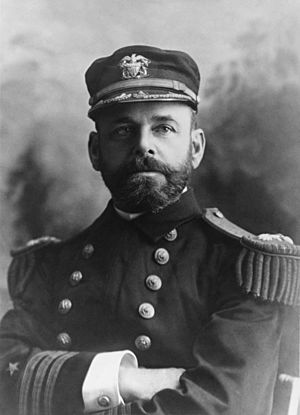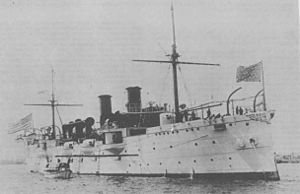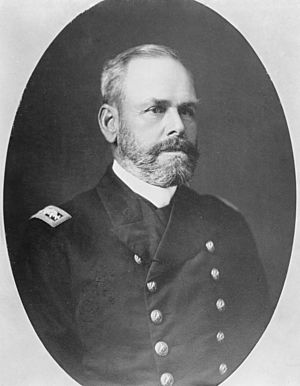Benjamin Franklin Tilley facts for kids
Quick facts for kids
Benjamin Franklin Tilley
|
|
|---|---|

Benjamin Franklin Tilley
|
|
| Born | March 29, 1848 Bristol, Rhode Island, United States |
| Died | March 18, 1907 (aged 58) Philadelphia, Pennsylvania, United States |
| Allegiance | United States |
| Service/ |
United States Navy |
| Years of service | 1863–1907 |
| Rank | Rear Admiral |
| Commands held | USS Bancroft USS Newport USS Vicksburg USS Abarenda USS Iowa Commandant of U.S. Naval Station Tutuila Commandant of League Island Naval Yard |
| Other work | Acting-Governor of American Samoa |
Benjamin Franklin Tilley (March 29, 1848 – March 18, 1907) was a dedicated officer in the United States Navy. He served from the end of the American Civil War through the Spanish–American War. He is best known as the first acting governor of American Samoa. He was also the territory's first naval governor.
Tilley joined the United States Naval Academy during the Civil War. He graduated after the war ended. He slowly moved up in rank. He helped protect American interests during the Great Railroad Strike of 1877. He also defended the American consulate in Santiago, Chile during the 1891 Chilean Civil War. During the Spanish–American War, his ship, the USS Newport, captured two Spanish Navy ships. After the war, he became the first acting governor of Tutuila and Manua. He helped set up laws and rules for this new territory. After 41 years of service, he was promoted to rear admiral. Sadly, he passed away shortly after from pneumonia.
Contents
Benjamin Franklin Tilley was born on March 29, 1848. He was born in Bristol, Rhode Island. He was the sixth of nine children. At 15, he joined the United States Naval Academy. This was on September 22, 1863, during the American Civil War. The war made the school move from Annapolis, Maryland to Newport, Rhode Island.
In 1866, he graduated at the top of his class. He served as a midshipman on the USS Franklin. Then he served on the USS Frolic for three years. He was promoted to ensign. His next ship was the USS Lancaster. There, he became a master in 1870 and a lieutenant in 1871. From 1872 to 1875, he served on the USS Pensacola in the South Pacific. After that, he served briefly on the USS New Hampshire. Then he spent two years on the USS Hartford.
Responding to the Railroad Strike of 1877
In July 1877, a large railroad strike started. It began in Martinsburg, West Virginia. This led to riots in cities like Pittsburgh and Philadelphia. President Rutherford B. Hayes allowed the military to respond.
Tilley was temporarily assigned to the USS Plymouth. He sailed up the Potomac River to Washington, D.C. Military leaders worried that rioters from Baltimore might attack government buildings. Troops defending Washington included the army, navy, and marines. They formed a Naval Brigade. Tilley was in charge of Company C. Luckily, the rioters did not come to Washington. The military quickly stopped the riots in other cities.
| Midshipman – 1867 | |
|---|---|
| 1867–1868 | USS Franklin |
| 1868–1869 | USS Frolic |
| Ensign – 1868 | |
| 1869–1872 | USS Lancaster |
| Master – 1870 | |
| Lieutenant – 1871 | |
| 1873–1875 | USS Pensacola |
| 1875 | USS New Hampshire |
| 1875–1877 | USS Hartford |
| 1877 | USS Plymouth |
| 1877–1878 | USS Powhatan |
| 1879–1881 | United States Naval Academy |
| 1881 | USS Standish |
| 1882 | United States Naval Academy |
| 1882–1885 | USS Tennessee |
| 1885–1889 | United States Naval Academy |
| Lieutenant Commander – September 1887 | |
| 1889–1890 | Washington Navy Yard |
| 1890–1893 | USS San Francisco |
| 1893–1897 | United States Naval Academy |
| 1896 | USS Bancroft |
| Commander – September 1896 | |
| 1897 | Naval War College |
| 1897–1898 | USS Newport |
| 1898 | Naval Station Newport |
| 1898–1899 | USS Vicksburg |
| 1899–1901 | USS Abarenda U.S. Naval Station Tutuila |
| Captain – October 1901 | |
| 1902–1905 | Mare Island Naval Shipyard |
| 1905–1907 | USS Iowa |
| 1907 | Philadelphia Naval Shipyard |
| Rear Admiral – February 24, 1907 | |
After the strike, Tilley moved to the flagship USS Powhatan. He then took a six-month break to get married. On June 6, 1878, he married Emily Edelin Williamson. She was the daughter of a Navy surgeon. They went on a long honeymoon in Europe.
When he returned, Tilley worked at the United States Naval Academy. He stayed there until 1882, teaching or on a training ship. For the next three years, he served on the USS Tennessee. In 1885, he became a lieutenant commander. He went back to teach at the academy. He became head of the Department of Astronomy, Navigation, and Surveying. Then he led the Department of Mechanical Drawing. In September 1889, he moved to the Washington Navy Yard to teach about weapons.
Protecting Americans During the Chilean Civil War
In 1890, Tilley was sent to San Francisco. He helped test the new USS San Francisco and became its executive officer. The San Francisco carried troops to Valparaíso during the 1891 Chilean Civil War. From there, the troops could protect the American consulate in Santiago. Rebels took over the city. Tilley stayed to defend the consulate with 100 men.
After the war, he returned to the naval academy. He again led the astronomy and navigation department. In 1896, he took command of the USS Bancroft. He sailed to inspect naval yards along the U.S. East Coast. He was promoted to commander that October. In 1897, he commanded the USS Newport. He sailed to Nicaragua to check on the progress of the isthmus canal project.
Serving in the Spanish–American War
On April 23, 1898, Spain declared war on the United States. This was because America supported Cuban independence. Tilley was in the Caribbean, commanding the Newport. He was right in the middle of the conflict. The United States declared war on Spain on April 25. Two days later, Tilley captured two Spanish Navy ships: the sloop Paquete and the schooner Pireno.
He helped with the naval blockade of Santiago de Cuba. However, he missed the Battle of Santiago de Cuba. His ship, the Newport, was getting fuel at Guantánamo Bay when the battle started. Near the end of the war, he shelled the Cuban port of Manzanillo. He and the Newport helped capture nine Spanish vessels. After the war, he was transferred to the Newport Naval Yard. In October, he was given command of the USS Vicksburg.
The United States wanted to build a naval station at Pago Pago, Samoa in 1872. A treaty was written, but the United States Senate did not approve it. On February 13, 1878, a new treaty was approved. It recognized the Samoan government. It also allowed the U.S. to build a naval station.
There were no more political problems. But money for the station was not provided. Only a small coaling station was built. Construction of the naval station did not start until 1898. Civilian companies led the work. In early 1899, Tilley was given the job of overseeing the station's construction. He also became its first commandant. He was also put in command of the USS Abarenda. This ship carried steel and coal to the construction site. It also served as the first station ship. After a long journey, he started his new job on August 13, 1899.
Even before Tilley arrived, the political situation in Samoa was changing. The Second Samoan Civil War had just ended. The islands had no working central government. The United States, the United Kingdom, and Germany all had interests in the area. The Tripartite Convention was signed on February 16, 1900. It divided the Samoan islands. The eastern part, with Tutuila, went to the United States. The larger western part went to Germany. The British government gave up its claims over Samoa. In return, Germany gave them some things in the Pacific and Africa.
After learning of the agreement, Tilley told the local chiefs. He stated that the United States was now in control. But a formal decision had not yet been made on how the U.S. government would manage the territory. Building the naval base was still his main job. He was sent to get more supplies and coal in Auckland, New Zealand. President William McKinley put the territory under the control of the United States Navy on February 19, 1900. Assistant Secretary of the Navy Charles H. Allen named Tilley commandant of United States Naval Station Tutuila. His mission was to "cultivate friendly relations with the natives."
Acting Governor of Tutuila
Tilley's first job as governor was to get the local leaders to sign a deed of cession. This would formally and peacefully transfer control to the United States. After Samoa was divided, two local governments remained on Tutuila. Both were open to joining the U.S. The people of Taʻu and Ofu-Olosega (together called Manu'a) were politically separate. They were about 70 miles (110 km) to the east.
On March 12, 1900, Tilley traveled to Taʻu. He met with the local king, Tui Manuʻa Elisala. The king agreed to give some power to the United States. But he did not agree to full control. The deed of cession was signed on April 17, 1900. It listed Manu'a as part of the new U.S. territory. But Manu'a's representative did not sign it. In this deed, Tilley was named Acting Governor. The territory did not have an official governor until 1905. Manu'a did not sign the deed until 1904. They did so after getting some agreements from the United States.
Tilley's first actions were to add a tax on imports. He also banned selling alcohol to local people (but not Americans). He also stopped the sale of Samoan lands to non-Samoans. On May 1, 1900, he announced that U.S. laws were in effect. But Samoan laws that did not conflict with U.S. law would remain. He divided the territory into three districts. These followed the historical divisions mentioned in the deed of cession. One was for each of the two governments on Tutuila. The third was for the islands of Manu'a.
Over the next year, Tilley regulated firearms. He made sure births, deaths, and marriages were recorded. He collected taxes. He made the sabbath a public holiday. He created a small militia of native Samoans. It was called the Fita Fita Guard. They served as defense and police. These local volunteers were trained at the naval station by a Marine sergeant.
Problems came up because Samoan and American laws sometimes clashed. For example, a local person caught and ate a skipjack. This was a sacred fish. Under Samoan law, it could only be eaten with a chief's permission. The traditional punishment was to burn the offender's house and uproot his crops. He would also be sent away from the territory. The person challenged this punishment using the American legal system. This led to the arrest of the chief who ordered the punishment. The chief was sentenced to a year of house arrest. Tilley was the judge. The chief also had to pay for the destroyed property.
There were similar issues with Samoan customs. They did not always fit well with the new American political divisions. For example, the territory's three district governors had equal power. But they had different social status in Samoan society. This made decisions harder and caused social tension. Despite these issues, the locals liked Tilley. On December 18, 1900, the local chiefs sent a letter to President McKinley. They congratulated him on his re-election. They said of Tilley, "you gave us a leader, a Governor, a High Chief, whom we have learned to love and respect."
Tilley took leave in June 1901 to return to Washington. E. J. Dorn took command. Dorn then had health issues. J. L. Jayne replaced him in October. That month, Tilley was promoted to captain by President Theodore Roosevelt. Tilley returned to Samoa on November 7, 1901, with his wife. Two days later, he faced a court martial (a military trial). The trial lasted four days. He was found not guilty. Despite this, Captain Uriel Sebree was appointed as commandant on November 27, 1901. Tilley and his wife returned to the United States the next month.
Sebree later said that Tilley had "great ability, kindness, tact and sound common sense." Tilley was not afraid to make laws and lead the territory. This was different from Sebree, who worried about having legal power to govern. The deed of cession recognized Tilley's authority. It gave him the title of Acting Governor. But to the U.S. government, he was only officially in charge of the naval station. As the first naval governor, Tilley set up much of the future government for the territory. It did not even have a formal name yet. The American Samoa government lists Tilley and other early commandants as territorial governors.
Later Career and Passing
Tilley's next job came in March 1902. He became a captain at the Mare Island Naval Shipyard in Vallejo, California. He stayed there for three years. Then he was assigned to the USS Iowa on January 11, 1905. On February 23, 1907, he became commandant of League Island Naval Yard in Philadelphia, Pennsylvania. He was promoted to rear admiral the next day. He died of pneumonia less than a month later, on March 18, 1907.
Tilley was one of 322 people who died in 1907. The Washington Post listed them as "foremost in their various callings." He was survived by one son and two daughters. His son, Benjamin Franklin Tilley, Jr., also joined the Navy. He retired as a lieutenant commander.




